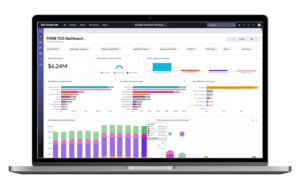Research from Gartner shows that strong CFO-CIO partnerships are 51% more likely to easily secure funding for digital initiatives and 18% more likely to achieve intended business outcomes.
The research also characterizes just 30% of these relationships as strong, revealing a critical gap where companies could be getting more from their technology investments.
Achieving true CFO-CIO alignment, however, demands more than just better communication. It requires unified data, shared language and a common framework for understanding the operational and financial impact of technology—all of which only IT financial management (ITFM) can deliver.
Free eBook: How to Produce an Effective Bill of IT Using Showback or Chargeback
The Underlying Disconnect Between CFOs and CIOs
While both the CFO and CIO aim to drive value and efficiency, their perspectives on technology spending are often at odds.
Finance doesn’t understand the tech when IT talks about the cost of standing up a Nutanix farm. When finance starts talking about depreciation and amortization of capital expenses, IT’s eyes glaze over.
This becomes an issue when CIOs lack the visibility to explain the value of technology investments in terms that matter to the CFO. When finance sees IT as a black box, the CFO is likely to make decisions based on total cost, rather than the value that spending delivers.
The Real Cost of CFO-CIO Misalignment
When CIOs can’t connect spending to value, IT is often starved by budget constraints. As many have discovered the hard way, this can have disastrous consequences.
One Fortune 500 company, for example, lost roughly $130M due to systemwide outages caused by a single failed switch that cost just $10,000 to replace.
Had business leaders truly understood the value of that switch, no doubt they would have purchased a dozen backups.
The incident underscores an unfortunate sequence of events in many organizations today:
- IT can’t tie spending to business outcomes.
- The company starves the IT budget because they don’t understand the value of IT spending.
- Underinvestment leads to failure, followed by an expensive mandate.
In the end, IT gets a blank check to ensure the problem never happens again—a far more expensive proposition than preventing it in the first place.
Linking Cost to Value: How ITFM Creates Shared Language and Data for CFOs and CIOs
CFOs want to know: What are we getting for this big check we’re cutting to IT? Are we investing in ways that support our overall strategy? Why does IT spend so much?
CIOs know that IT doesn’t spend money on its own. Business leaders make decisions, and IT executes on them. ITFM provide a defensible, unified data view that connects those spending decisions to organizational value, showing the outcomes delivered to drive more strategic conversations.
ITFM gives the CIO a way to communicate back to the CFO:
- How IT tracks its cost footprint
- Total cost of ownership (TCO) and multi-year cost implications of decisions
- Which decision levers will have the biggest impact on reducing costs
- How IT expenses are linked to different products and enterprise strategies
- The cost of IT in terms that matter most to the business, whether it’s IT cost per insurance claim, per barrel of oil or per transaction
This makes IT a far less likely target for cuts, especially when CIOs can show that the cost of IT per unit is going down despite overall spending increases.
The Critical Element in Communicating Value to CFOs
There’s one specific ingredient you’ll need if you want CFOs to trust the data you’re showing them: operational detail. The issue is that legacy ITFM software tools often use aggregated line-item expenses (a necessity when the software can’t quickly process millions of lines of data).
There are several problems with this approach:
- If the CIO tells the CFO that a capability costs $10M without being able to show a detailed cost breakdown, it makes it hard to optimize those costs in an intelligent way.
- The lack of detail means that when you pull a lever, the costs may not change as much or as quickly as you expect.
- In some cases, business decisions can lead to unintended impacts, as teams don’t fully understand how specific costs are tied to different areas of operations.
To manage technology costs while still pushing the business strategy forward, you need a highly accurate, detailed cost model, where you pull a lever and see the results change quickly.
That requires a modern, high-powered ITFM solution like Nicus that preserves all the operational detail from the general ledger to enable surgical precision in optimizing the cost footprint.
For example, when IT can show that consolidating four applications into one will save $2M annually—and you can see those results immediately leave your footprint without impacting IT delivery—that’s a powerful lever for change.
IT budget discussions focused solely on total costs are a losing proposition for IT, finance and the business as a whole. The real question is not just how much are you spending, but how does that spend connect to value in terms that the business cares about?
ITFM gives CIOs and CFOs the ability to answer those questions, providing a shared foundation, dataset and language for achieving business goals.







